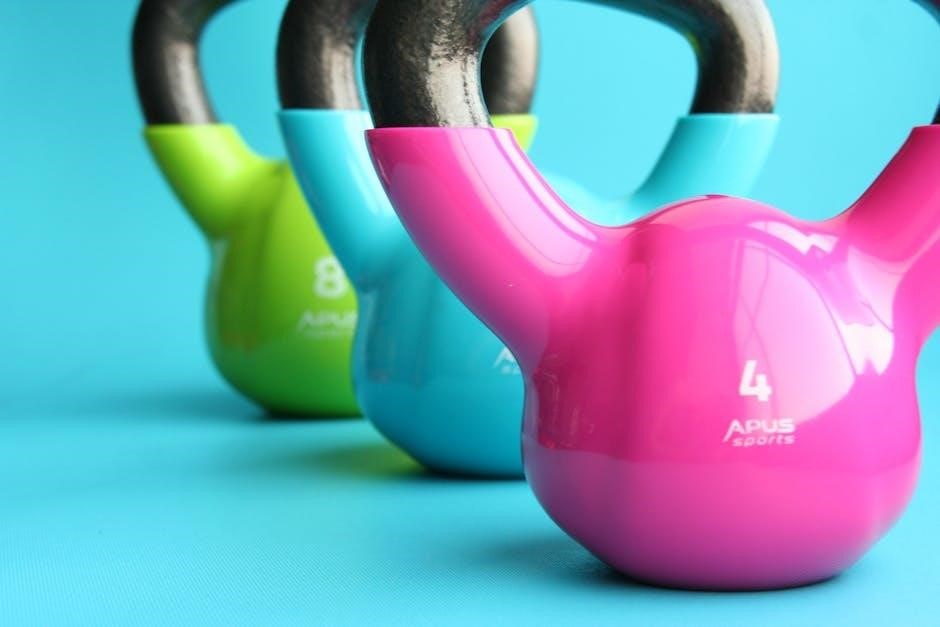Embracing a healthy lifestyle is essential for overall well-being. It involves balanced nutrition, regular exercise, quality sleep, and mental mindfulness. Small, sustainable changes can lead to significant long-term benefits.
1.1 Understanding the Importance of Health and Wellness
Health and wellness are foundational to a fulfilling life, encompassing physical, mental, and emotional well-being. Prioritizing health reduces the risk of chronic diseases like heart disease, cancer, and stroke. Small, sustainable changes, such as balanced nutrition, regular physical activity, and quality sleep, can lead to significant long-term benefits. Wellness also involves environmental awareness, like avoiding toxins in food, air, and water, and adopting eco-friendly practices. By making mindful choices, individuals can enhance their resilience, improve mental clarity, and foster a sense of purpose. Understanding the importance of health and wellness empowers individuals to take proactive steps toward a healthier, more vibrant life.
1.2 Setting Realistic Goals for a Healthy Lifestyle
Setting realistic goals is crucial for adopting and maintaining a healthy lifestyle. Start by identifying small, achievable changes, such as incorporating more nutritious meals or short daily walks. Create a personalized plan that aligns with your values and lifestyle, ensuring it is both challenging and attainable. Break larger goals into manageable steps to avoid overwhelm and track progress regularly. Celebrate milestones to stay motivated and adjust goals as needed. Avoid perfectionism and focus on consistency, allowing flexibility for setbacks. By setting clear, realistic objectives, you can build confidence and create a sustainable path toward long-term health and well-being.
Nutrition and Diet
A balanced diet is the cornerstone of a healthy lifestyle, providing essential nutrients for optimal energy and well-being. Focus on whole, nutrient-rich foods to fuel your body.
2.1 The Role of Balanced Meals in a Healthy Diet
A balanced meal is the foundation of a healthy diet, providing the body with essential nutrients, vitamins, and minerals. It includes a variety of foods such as whole grains, lean proteins, fruits, vegetables, and healthy fats. These components work together to support energy levels, immune function, and overall well-being. Incorporating a mix of these food groups ensures that nutritional needs are met, reducing the risk of deficiencies. Balanced meals also promote better digestion and satisfaction, helping to maintain a healthy weight and prevent chronic diseases. By prioritizing whole, nutrient-dense foods, individuals can create a diet that supports long-term health and vitality.
2.2 Hydration: The Key to Optimal Health

Hydration is crucial for maintaining optimal health, as water makes up a significant portion of the human body. It plays a vital role in bodily functions, such as regulating body temperature, transporting nutrients, and removing waste. Even mild dehydration can lead to fatigue, dizziness, and decreased physical performance. Drinking enough water daily is essential for overall well-being. Aim to consume at least eight glasses of water a day, adjusting for activity levels and climate. Incorporating water-rich foods and limiting sugary drinks can also support hydration. Staying hydrated not only enhances energy levels but also promotes healthy skin and digestion, making it a cornerstone of a healthy lifestyle.
2.3 Mindful Eating: A Guide to Better Food Choices
Mindful eating is a powerful practice that enhances your relationship with food, promoting healthier choices and greater satisfaction. It involves paying attention to your body’s hunger and fullness cues, savoring each bite, and eating without distractions. This approach helps reduce overeating and supports better digestion. By listening to your intuition, you can make nourishing decisions that align with your health goals. Avoiding processed foods and choosing whole, organic options when possible can further optimize your diet. Mindful eating fosters a deeper connection to your body and the food you consume, leading to a more balanced and fulfilling eating experience.

Physical Activity
Regular physical activity is crucial for a healthy lifestyle. It reduces disease risks, boosts energy, and enhances mental well-being. Find exercises you enjoy to stay consistent.
3.1 Types of Exercise: Finding What Works for You
Exploring various types of exercise helps you discover what suits your lifestyle and preferences. Cardiovascular exercises, such as running or cycling, improve heart health and burn calories. Strength training, like weightlifting or bodyweight exercises, builds muscle and boosts metabolism. Flexibility and balance exercises, such as yoga or Pilates, enhance mobility and reduce injury risk. High-Intensity Interval Training (HIIT) is great for time-efficient workouts, while low-impact activities like swimming are ideal for joint health. The key is to find a routine that you enjoy and can maintain consistently. Mixing different types of exercise keeps your workouts engaging and ensures overall fitness.
3.2 Creating a Consistent Workout Routine

Consistency is key to achieving fitness goals. Start by setting specific, achievable objectives and scheduling workouts in your daily planner. Begin with manageable routines, such as 30 minutes most days of the week, and gradually increase intensity or duration. Tracking progress through journals or apps can motivate adherence. Varying workouts to include strength training, cardio, and flexibility exercises ensures a well-rounded routine. Incorporate activities you enjoy to maintain interest and commitment. Remember, rest days are essential to avoid burnout and allow muscle recovery. A consistent routine not only improves physical health but also enhances mental well-being and overall energy levels.
3.3 Avoiding Sedentary Behavior: Staying Active Daily
Avoiding sedentary behavior is crucial for maintaining physical and mental health. Incorporate movement into your daily routine by taking short walks during breaks, using stairs instead of elevators, or stretching while working. Even light activities, like household chores or gardening, contribute to overall activity levels. Reducing screen time and encouraging family or friends to join can make staying active more enjoyable. Small, consistent efforts, such as standing while on calls or pacing during meetings, can significantly reduce sedentary habits. Regular movement helps prevent chronic diseases, improves mood, and boosts energy levels, fostering a healthier lifestyle overall.
Mental and Emotional Well-being
Mental and emotional well-being are vital for a healthy lifestyle. Practices like mindfulness, self-care, and building strong social connections help reduce stress and improve resilience.
4.1 Managing Stress for Better Health
Managing stress is crucial for maintaining overall health. Chronic stress can lead to various health issues, including anxiety and a weakened immune system. Incorporating mindfulness practices, such as meditation and deep breathing, can help reduce stress levels. Engaging in regular physical activity, like yoga or walking, also promotes relaxation and emotional balance. Additionally, setting realistic goals and prioritizing tasks can help alleviate feelings of overwhelm. Self-care practices, such as getting adequate sleep and connecting with loved ones, further support mental well-being. By addressing stress proactively, individuals can enhance their resilience and improve their quality of life.

4.2 The Importance of Self-Care Practices
Self-care is a vital component of a healthy lifestyle, fostering emotional and physical well-being. It involves intentional activities that nourish the mind, body, and soul, such as meditation, reading, or spending time in nature. Prioritizing self-care helps reduce stress, boosts resilience, and enhances overall life satisfaction. Simple practices like setting boundaries, taking relaxing baths, or engaging in hobbies can make a significant difference. Self-care is not a luxury but a necessity for maintaining balance in a fast-paced world. By incorporating self-care into daily routines, individuals can cultivate a stronger connection with themselves and improve their ability to thrive in all areas of life.
4.3 Building Strong Social Connections
Building strong social connections is crucial for emotional and mental well-being. Engaging with others fosters a sense of belonging, reduces stress, and enhances overall happiness. Simple acts like spending time with loved ones, joining community groups, or volunteering can strengthen relationships. Shared activities, such as group exercises or hobbies, create opportunities for bonding and mutual support. Prioritizing communication and empathy in interactions helps deepen connections. A robust social network not only provides emotional support but also encourages accountability and motivation in maintaining a healthy lifestyle. By nurturing relationships, individuals can build a supportive environment that promotes long-term well-being and resilience in all areas of life.

Sleep and Recovery
Sleep is vital for physical and mental restoration. Prioritizing quality sleep enhances recovery, boosts energy, and supports overall well-being, making it a cornerstone of a healthy lifestyle.

5.1 The Science of Sleep Hygiene
Sleep hygiene is a set of practices designed to improve sleep quality. It involves maintaining a consistent sleep schedule, creating a relaxing bedtime routine, and optimizing the sleep environment. Avoiding screens, caffeine, and heavy meals before bed can enhance sleep hygiene. A dark, quiet, and cool bedroom promotes better rest. Limiting naps and avoiding stimulating activities in the evening also supports healthy sleep patterns. By prioritizing these habits, individuals can address sleep disorders and improve overall well-being. Consistent sleep hygiene practices are essential for physical and mental recovery, ensuring a refreshed and energized start to each day.
5.2 Creating a Restful Sleep Environment
A restful sleep environment is crucial for improving sleep quality. Start by ensuring your bedroom is dark, quiet, and cool, using blackout curtains or earplugs if necessary. Invest in a comfortable mattress and pillows to support proper alignment. Keep electronic devices out of the room to minimize distractions. Incorporate calming colors and soft textures to create a soothing atmosphere. Avoid harsh lighting and opt for dim red bulbs instead. Consider using natural cleaning products to reduce toxins and promote freshness. Adding plants or essential oils, like lavender, can enhance relaxation. A clutter-free space also contributes to a peaceful environment, helping you unwind and prepare for restful sleep.
Environmental Health
Environmental health involves avoiding toxins, choosing organic options, reducing plastic use, and using natural products to minimize exposure and promote overall well-being.
6.1 Avoiding Toxins in Your Daily Life
Avoiding toxins is crucial for maintaining environmental health. Reduce exposure by choosing organic foods, minimizing plastic use, and selecting natural cleaning products. Limit contact with harmful chemicals in personal care items and household products. Awareness of air and water quality can also reduce toxic burden. Simple changes, like using non-toxic cookware and avoiding synthetic fragrances, make a difference. Prioritizing natural environments and reducing pollution exposure further supports well-being. By making informed choices, you can significantly lower your toxic load and promote long-term health benefits.
6.2 The Impact of Sustainable Living on Health
Sustainable living significantly impacts health by reducing exposure to environmental toxins and promoting overall well-being. Choosing eco-friendly practices, such as using natural cleaning products and reducing plastic use, lowers toxic burden. Sustainable habits like buying organic foods and conserving water contribute to cleaner air and healthier ecosystems. These practices reduce the risk of chronic diseases and improve mental health by fostering a connection to nature. By adopting sustainable lifestyles, individuals can create a healthier environment for themselves and future generations, ensuring long-term physical and emotional well-being.

Setting Realistic Goals
Setting realistic goals is crucial for a sustainable healthy lifestyle. Start with small, achievable steps, like improving diet or increasing physical activity, to build lasting habits.
7.1 Creating a Personalized Health Plan
A personalized health plan is tailored to your unique needs and goals. Start by assessing your current habits, including diet, exercise, and stress levels. Set realistic objectives, such as improving nutrition or increasing physical activity, and outline actionable steps to achieve them. Incorporate strategies for mindfulness, sleep hygiene, and environmental health to ensure a holistic approach. Regularly monitor progress and adjust the plan as needed to stay on track. A well-structured plan not only helps you stay motivated but also ensures sustainable long-term results. Remember, small consistent changes can lead to significant improvements in overall well-being.

Tracking Progress
Tracking progress is crucial for maintaining motivation and accountability. Use journals, apps, or wearable devices to monitor your journey and celebrate small achievements along the way.
8.1 Monitoring Your Journey to a Healthier Lifestyle

Monitoring your progress is essential to staying motivated and ensuring long-term success. By tracking your daily habits, you can identify patterns and make necessary adjustments. Use tools like journals, mobile apps, or wearable devices to log your meals, physical activity, and sleep quality. Setting realistic milestones helps break down larger goals into manageable steps. Regularly reviewing your progress allows you to celebrate achievements and address areas for improvement. This consistent reflection fosters accountability and helps maintain a positive mindset. Over time, monitoring your journey becomes a habit, empowering you to sustain healthy choices and continue growing toward your wellness goals.




